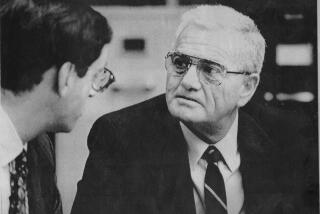Recovered Memory Murder Case Unravels
FOSTER CITY, Calif. — In the annals of criminal law, there has never been anything quite like the case of the People vs. George Thomas Franklin Sr.
Franklin, a craggy-faced middle-aged man, was living near Sacramento in 1989 when his grown daughter, Eileen Franklin-Lipsker of Canoga Park, came forward and told an incredible tale.
As a child 20 years earlier, she said, she witnessed her father rape her childhood friend, 8-year-old Susan Nason, then smash the little girl’s skull with a rock. Even moreastonishing, Franklin-Lipsker said she had repressed the memory for two decades, recovering it only after her own daughter neared Susan’s age.
Armed with Franklin-Lipsker’s story, San Mateo County prosecutors reopened the long-forgotten murder and won a conviction in 1990. Superior Court Judge Thomas M. Smith denounced Franklin as “wicked and depraved,” and sentenced the onetime firefighter to life in prison. It was a first. Never before had recovered memory been used in a criminal prosecution.
*
Franklin remains in prison today. But the case against him seems to be unraveling. U.S. District Judge Lowell Jensen, appointed to the bench by President Ronald Reagan in 1986, reversed the conviction this year, concluding that “the risk of an unreliable outcome in this trial is unacceptable.”
San Mateo County Dist. Atty. Jim Fox is expected to decide within a month whether to try Franklin again or allow his release. But even as prosecutors remain convinced of Franklin’s guilt, they know that persuading a jury beyond a reasonable doubt that Franklin committed the murder 26 years ago will be far more difficult the second time.
“Let’s be honest, in the five years since the conviction, there is a whole lot more skepticism about repressed memory,” said Deputy Atty. Gen. Bruce Ortega, who argued the prosecution’s case on appeal.
The crucial question facing prosecutors is whether a jury would trust the reliability of repressed memories enough to win a conviction. Mental health experts are divided over whether recollections called up years after an event are real and numerous recantations in similar cases in the years since the Franklin conviction have fortified the doubters.
“There is no good scientific support for it,” said Dr. Elizabeth Loftus, University of Washington professor of psychology. “We should not be dragging people through the courts on folklore.”
Loftus testified for the Franklin defense in the first trial, and since has joined the ranks of the harshest critics of the recovered memory theory. But like many others, she wants a Franklin retrial, hoping it will help resolve the debate.
“The psychotherapy community is so viciously divided on the subject, and that vicious division may play itself out in the trial,” Loftus said.
Before making their decision on whether to retry Franklin, San Mateo County prosecutors are studying the latest science on repressed memory and talking to experts.
“From the beginning, we felt the man did commit the crime,” Chief Deputy Dist. Atty. Stephen Wagstaffe said. “But you can never take a case to trial unless there is reasonable probability that the jury will return a verdict of guilty.”
*
For all the problems, there are powerful reasons for a retrial, not the least of which is the attention the case attracted. Franklin-Lipsker’s story has been the focus of two books, including one she coauthored, plus chapters in other books, and a made-for-TV movie. Most important, if they drop the case, prosecutors would be acknowledging that they discount a story that kept a man in prison for five years.
“Politically, they’ve got to retry it,” Harry Maclean, a lawyer who wrote one of the Franklin books, “Once Upon a Time.” “They’re going to give it to the jury, and let the jury decide. There’s no way to back off.”
When the story began in September, 1969, the Nasons and the Franklins lived a few doors from one another in Foster City, then a quiet tract populated by young families and lined with inexpensive homes built on bay fill. Developers tried to make it more idyllic by carving a series of lagoons.
To the families there, the neighborhood radiated safeness.
Susan Nason and Eileen Franklin were third-graders at a school down the block from their homes. One autumn afternoon, Susan’s mother sent the child on a brief errand. She never returned.
The little girl’s remains were found months later, left under an old mattress, near Crystal Springs Reservoir about 15 miles west of Foster City. A ring on her finger was bent, suggesting she had tried to ward off blows. What leads there were dried up over time.
The Franklin family, meanwhile, fractured. In seeking a divorce, Leah Franklin, the mother, said her husband abused her verbally and physically. Before divorcing him, she once questioned him about the Nason murder, she testified at the trial. Eileen and one of her sisters also said their father molested them. In 1984, Eileen’s sister told police she suspected her father killed the Nason girl but had no hard facts to support her story.
It wasn’t until 20 years after the murder that Eileen Franklin-Lipsker’s memories led to an arrest. She was in the den of her home when she caught the gaze of her daughter. From that, she said, she began recalling the awful memories. Pushed and prodded by her husband, Barry Lipsker, who has since died, she went to San Mateo County authorities.
During the trial, Franklin-Lipsker said she recalled being in her father’s Volkswagen van when he picked up Nason, drove to an isolated spot, and climbed on top of the little girl. She testified that when Nason wouldn’t stop crying, he smashed her skull. Franklin-Lipsker’s memories were not perfect, but she testified about many details, among them the ring Susan was wearing.
Franklin-Lipsker was in the courtroom as the verdict was read, and embraced Susan Nason’s mother. “There can’t be a true victory for me because it is my father,” she said at the time.
*
After the conviction came the movie, the book, talk show appearances and speaking engagements by Franklin-Lipsker. All the while, San Francisco attorney Dennis Riordan, a specialist in criminal appeals, pressed Franklin’s case.
In April, Jensen issued his ruling, and the U.S. 9th Circuit Court of Appeals affirmed it last month. Jensen did not base his ruling on whether recovered memories are real. In fact, he said such memories can be used in trials.
“Admissibility of the memory is but the first step; it does not establish that the memory is worthy of belief,” wrote Jensen, once the No. 2 man in the Justice Department under President Reagan.
Among his findings, Jensen ruled that the trial judge erred by refusing to permit Franklin’s trial attorney, Douglas Horngrad, to introduce 1969 and 1989 news accounts of the murder. Those accounts revealed many of the details to which Franklin-Lipsker testified.
“This is a tragic event which cries out for resolution,” Jensen wrote, “but it cannot be resolved by a trial where violations of the Constitution have eliminated the necessary presence of fundamental fairness.”
Further undercutting Franklin-Lipsker’s story, one of her sisters submitted a statement to the court swearing that she saw Franklin-Lipsker watch a news account that showed the murder scene, something Franklin-Lipsker denied. And her mother, previously a prosecution witness, has come to disbelieve the concept of recovered memories and her daughter’s story.
“I realized it was all wrong,” Leah Franklin said in a recent interview. “I got some information, I believed it, and I later found it was wrong.”
Franklin-Lipsker’s story, and the trial that followed, was the first of its kind to attract widespread attention. But in the years since, countless other adults rose from therapists’ couches with claims that they too had repressed memories of being molested years before. Many brought civil lawsuits against their parents and others they said committed the acts. Roughly half the states, including California, passed laws permitting adults to bring lawsuits based on recovered memories.
But almost as quickly as the concept of recovered memory was accepted, the backlash began. Some so-called victims retracted their accusations. Many sued therapists for implanting the memories. In August, a Minnesota jury awarded $2.7 million to a woman in such a case. Other cases have brought six-figure awards, including $500,000 granted in 1994 to Gary A. Ramona, a Napa father who sued a therapist who treated his daughter, after the daughter accused Ramona of molesting her.
In New Hampshire, a judge in September held that the theory of recovered memory “has not gained general acceptance in the field of psychology,” and refused to allow testimony in a criminal sexual abuse case. That case is on appeal.
In the first such ruling in California, Los Angeles Superior Court Judge James Sutton in September refused to permit recovered memory testimony in a lawsuit by a man who says he was molested by his father.
Sutton made the decision after hearing testimony from therapists on both sides of the debate, and concluded that the theory is “junk science.” The son is appealing the decision.
Despite the setbacks, some mental health experts remain convinced that recovered memory is trustworthy. Several cite documented instances in which trauma, from military battlefields to sexual attacks, is repressed, then recalled later in life.
“I’ve seen it,” said Dr. Laura S. Brown, a clinical professor of psychology at University of Washington. “I also know that it’s not a perfect report. People have details out of sync. But essential core facts often turn out to be true.”
Brown and Loftus are on a panel of six experts appointed by the American Psychological Assn. to study the issue.
*
While that work continues, Dr. Dorothy Cantor, incoming president of the association, said that although she, too, has seen evidence of recovered memories in her own practice, she is skeptical that such memories should be used as the foundation of a prosecution.
“To make the sole basis of a conviction,” Cantor said in a recent interview, “the uncovering of a repressed memory, with no other validating evidence, would seem to me to go beyond reasonable doubt--not because we’re skeptical of all repressed memory, but because the state of the art, the state of the science, is such that we’re just not that good.”
But to Don Nason, the father who lost his little girl so many years ago, all the debating seems beside the point. As far as he is concerned, the right man is in prison.
“What can I say? It would really be an injustice if he got off.”
More to Read
Sign up for Essential California
The most important California stories and recommendations in your inbox every morning.
You may occasionally receive promotional content from the Los Angeles Times.










